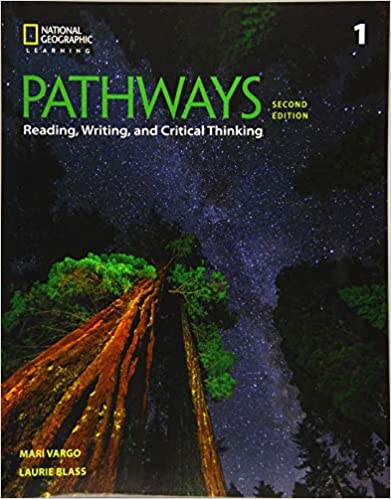
Publishers Description: Pathways, Second Edition, is a global, five-level academic English program. Carefully-guided lessons develop the language skills, critical thinking, and learning strategies required for academic success. Using authentic and relevant content from National Geographic, including video, charts, and other infographics, Pathways prepares students to work effectively and confidently in an academic environment.
Citation: Blass, Laurie, and Mari Vargo. Pathways – Reading, Writing, and Critical Thinking. Second ed., ser. L1, National Geographic Learning, 2018.
ISBN: ISBN-10 : 1337407763 ISBN-13 : 978-1337407762
Buy: https://www.amazon.com/dp/1337407763?psc=1&ref=ppx_yo2_dt_b_product_details
Overview:
National Geographic’s second edition textbook Pathways: Reading, Writing, and Critical Thinking by Mari Vargo and Laurie Blass is Level 1. Therefore it would be ideal for Level One introductory proficiency in the English Language and aimed towards middle school or high school age students. The American Council for Teaching English as a Foreign Language highly recommends a textbook containing the 5 C’s: Communication, Culture, Connections, Comparisons, , & Communities (Mihai & Permensky). While all of these can be found in the text to varying degrees, it does a particularly good job with culture and communication.
In the Pathways text, the tasks vary in level of difficulty. The text does a good job of engaging different students who have different learning styles such as audio or visual learners. There are lots of recent, vibrant photos of cultures all around the globe (one of the 5 C’s). There are many brainstorming and predicting questions, such as the one found on p. 84 in Chapter Five: Food Journeys: “What are some typical dishes in your country or culture? Make a list and share your ideas with a partner?” This is a good example of connections, cultures, and also communication because it calls for speaking (with a partner) and gain more skills. There are also text bubbles labeled “critical thinking” which ask for deeper understanding of the material, such as the following: “Justifying means explaining the reasons for your opinion or preference. For example, when you evaluate something, think about how and why you made your decision” (87). In addition, the text also has lots of cross-disciplinary materials that explore subjects such as business, psychology, earth science, etc.
One aspect of the book that instructors may want to keep in mind is that In all the chapters there is a section labelled video which can be confusing because there are no links to videos, but instead the section asks the readers to interact with a photo on the page and analyze and think/talk about it. However, if one looks up some keywords such as the photographer’s name and title of the image, there is often a video on YouTube that could help expand the text. Instructors could compile a list or URLs to corresponding National Geographic videos. There is also a little headphone symbol beside some of the reading material, most likely to a CD that corresponds with the text, but that didn’t come with mine because I bought used. However, instructors could just as easily read aloud certain passages to students who may be audio learners, or partner students up to read to each other. Overall, I think this text would be a wonderful fit for an introductory level class of middle/high school age students. A growing number of students are more visual learners, and the Pathways text more than meets those needs. What may be lacking in the text is easily expandable on behalf of the instructor, without the instructor spending extraneous amounts of time on it.
Chapter Evaluation:
Chapter 7: Food Journeys is very clear in the goals of the chapter. It is broken down on the first page into four subjects: reading, writing, grammar, and critical thinking and then lists what the goals are respectfully for each of those subjects (recognizing pronoun references, paraphrasing using synonyms, giving reasons, justifying your opinion). Using interactive activities and images the text explores these subjects through the gaze of food ways.
In the text, the easier tasks are towards the beginning, such as matching words to their definitions and acquiring new skills. Harder skills, like writing and formulating full paragraphs, exploring and understanding larger pieces of written English, are at the end of the chapter and require applying the acquired skills. The chapter is mapped out and very clear so as to have as little confusion as possible, and there are a variety of tasks in various skill sets. Each chapter follows a similar mapping, with different subject matter/lens.
Overall, the text is very engaging and put together. There are very clean photos and easy to follow instructions, and the authors were very creative in incorporating so many different cultures, subjects, and disciplines. In Chapter 7, the student is asked not only to explore other cultures food traditions, but also be able to reflect on their own. However, one thing to keep in mind is to make sure you have the accompanying CD is you plan on catering more towards audio learners. For audio/visual learners the instructor may have to adapt the material and search for relevant national geographic videos or other authentic materials outside the text. Naturally, because it is a textbook there is more of an emphasis on written English and reading rather than speaking. There could be more activities that include speaking that involve a whole classroom, not just with a partner. All in all, he Pathways text is wonderful for any TESOL instructor who wants to engage their students in a variety of ways and can also be adapted to fit into different classroom structures.